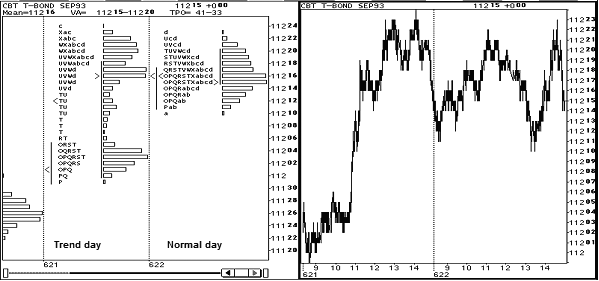Tips on Technicals - Market Profile©
| Indicator type: |
Display type |
| Used to: |
Analyze time and price relationships |
| Markets: |
All cash and futures, not options, although it was designed for CBT Bond trading. |
| Works Best: |
Active markets |
| Formula: |
N/A |
| Parameters: |
The 30-minute interval is most common although profiles comprising 15-minute and multiple days of 30-minute intervals are used.
The price interval used is related to the trading range for the instrument. US Bonds use their tick size of 1/32. Forex may use an interval of 10 or 50 points (.0001 = one point in most currencies). Indices such as the Nikkei 225 stock Index may use 100 point intervals.
|
| Theory: |
Market Profile looks at trading activity from a time and price point of view. According to its creator, Peter Steidlemayer, the market regulates itself in terms of both. The 30-minute time interval used is small enough to capture intraday activity but is long enough to allow traders to act.
Each combination of time and price is called a "time-price opportunity." The theory behind it states that the more time the market spends at a specific price range, the more significant that range becomes in representing fair value.
The display looks like a histogram on its side. Each half-hour segment is assigned a letter. Whenever the market trades at a given price during a given half hour, that half hour's letter is recorded next to the price. If that price is traded in a subsequent half hour, that half hour's letter is added to the first and so forth. Opportunities are created when price moves away from an established value area as prices generally return to fair value.
|
| Interpretation: |
The shape of the profile helps the trader determine the type of day it will be. These types are normal day, trend day and non-trend day. Normal days have bell-shaped curves and occur 80% of the time. They indicate normal activity, as buyers and sellers test each other.
Trend days are long and flat (see charts on next page). Here, the market is moving smoothly and spends a small amount of time at each price. This occurs 15% of the time. The remaining 5% is spent in non-trend days. The profile is narrow as only a few prices are traded. All the letters pile up at these levels.
|

While both Market Profile (left) and tick charts (right) use trade by trade data, the former groups price action automatically to reveal where the market assigned value throughout the trading day.
The following are the Market Profile Components:
| Letter: |
Each 30-minute period is assigned a letter. |
| Histogram: |
Horizontal indication of percentage of trade activity at each price. This is a proxy for the Liquidity Data Bank©, which measures not only the volume of activity but who was trading it. |
| 1st left-pointing arrow: |
The item's open price. |
| 2nd left-pointing arrow: |
The day's mean price. |
| Left vertical bar: |
The pioneer range comprising the first 60 minutes of trading. |
| Right vertical bar: |
The day's value area where 70% of the volume (or trades, if volume is not available) took place. |
| Right-facing arrow: |
The last or close price. |
| TPO (Time-Price Opportunity) |
The mode price (the one with the most letters assigned) is excluded. The numbers of letters above and below this price are added together, respectively and displayed in the marquee. Prices at the extremes with single letters are also excluded. The TPO count indicates how much the fair value area may be skewed. |



